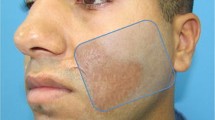Abstract
Background
This study aimed to compare the difference between the skin expansion and contraction rates for an expanded flap with one versus two expanders.
Methods
The study cohort comprised 24 cases of two overlapping expanders and 15 cases of a single implanted expander involving 22 patients. The method of “wet-cloth sampling” was applied to measure the expanded flap area and the initial unexpanded area and to calculate the skin expansion rate. Two points 5 cm apart in the center of the expanded flap were selected before the second surgical stage. After removal of the expander, the distance between the two fixed points was measured and recorded. The contraction rate of the expanded flap then was calculated.
Results
During the same period of expansion in the two groups (p = 0.06, >0.01), the skin expansion rate was 3.5 ± 0.9 % in the group with two overlapping expanders and 2.6 ± 0.6 % in the control group. The difference between the two groups was statistically significant (p = 0.002, <0.05). The instantly expanded flap contraction rates were 30.3 ± 0.8 and 32.3 ± 0.9 %, respectively for the two groups, and the difference was not statistically significant (p = 0.47, >0.05). We fitted a linear regression model that was Y = 0.533 − 0.003X, where Y was the contraction rate of the expanded flap and X was the period of expansion. The contraction rate of the expanded flap was negatively correlated with the period of expansion.
Conclusions
Compared with the traditional method of implanting a single expander, the new method of overlapping two expanders in a single cavity increased the skin expansion rate. The instantly expanded flap contraction rate did not differ significantly between the two groups, so the amount of expanded skin area absolutely increased. The clinical application of the new method is worth promoting.
Level of Evidence V
This journal requires that authors assign a level of evidence to each article. For a full description of these Evidence-Based Medicine ratings, please refer to the Table of Contents or the online Instructions to Authors www.springer.com/00266.






Similar content being viewed by others
References
Radovan C (1982) Breast reconstruction after mastectomy using temporary expander. Plast Reconstr Surg 69:195–206
Zhang GL, Zhang JM, Liang WQ et al (2012) Implant double-tissue expanders superposingly in mastoid region for total ear reconstruction without skin grafts. Int J Pediatr Otorhinolaryngol 76:1515–1519
Leighton WO, Russel RC, Marcus DE et al (1986) Experimental expansion of cutaneous and myocutaneous free flap donor sites: anatomical, physiological, and histological changes. Plast Surg Forum 9:262
Stark GB, Hong C, Narayanan K et al (1986) The use of a tissue expander to elongate axial blood vessels. Plast Surg Forum 9:151
Johnson T, Lowe L, Brown M (1993) Histology and physiology of tissue expansion. J Dermatol Surg Oncol 19:1074–1078
Alex JC, Bhattacharyya TK, Smyrniotis G et al (2001) A histologic analysis of three-dimensional versus two-dimensional tissue expansion in the porcine model. Laryngoscope 111:36–43
Brobmann GF, Huber J (1985) Effects of different-shaped tissue expanders on transluminal pressure, oxygen tension, histopathologic changes, and skin expansion in pigs. Plast Reconstr Surg 76:731–736
Zeng YJ, Xu CQ, Yang J et al (2003) Biomechanical comparison between conventional and rapid expansion of skin. Br J Plast Surg 56:660–666
Pietila JP, Nordstron RE, Virkklmen P et al (1988) Accelerated tissue expansion with the “overfilling” technique. Plast Reconstr Surg 81:204
Dierce GF, Vandsberg J, Rucdolph R et al (1991) Platelet-derived growth factor-beta and transforming growth factor-beta selectively modulate glycosaminoglycans, collagen, and myofibroblasts in excision wounds. Am J Pathol 138:629–633
Chang B, Tuchler RE, Siebert JW et al (1992) The effect of tissue expansion on dermal fibroblast contraction. Ann Plast Surg 28:315–319
Xu J, Liu Y, Mu L et al (2002) Overlapping tissue expansion techniques and its clinical applications. Chin J Plast Surg 18:369–370
Conflict of interest
The authors declare that they have no conflicts of interest to disclose.
Author information
Authors and Affiliations
Corresponding author
Additional information
Gan-lin Zhang and Jin-ming Zhang have contributed equally to this study.
Rights and permissions
About this article
Cite this article
Zhang, Gl., Zhang, Jm., Ji, Cy. et al. A Comparison of Skin Expansion and Contraction Between One Expander and Two Expanders: A Preliminary Study. Aesth Plast Surg 37, 1202–1208 (2013). https://doi.org/10.1007/s00266-013-0225-y
Received:
Accepted:
Published:
Issue Date:
DOI: https://doi.org/10.1007/s00266-013-0225-y




